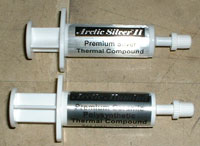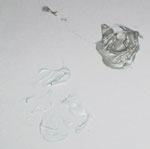|
|
|
Arctic Alumina TIM Review Date: November 15, 2001 |
| Provider: Arctic Silver |
| Manufacturer: Arctic Silver |
| Author: Mikhail Ivanenkov |
|
Before I begin I'd like to thank Nevin House from Arctic Silver for sending over both the thermal paste and the epoxy for evaluation. Arctic Silver and consequently Arctic Silver 2 were and still are without a doubt the best thermal compounds on the market. There are others that are competitive: OCZ and Coolermaster and Nanotherm all have their takes, but they just aren't as good. Close, but not quite there. Well, the folks at AS2 decided to go one step further. The biggest problem with AS2 was the price. Costing around $20 at release and about $10 now, it's still quite a money monger. And a 3 gram tube holds enough paste for 20-30 CPU applications. Most people never do more than 5. Unfortunately this is still a problem, but it's getting better. The new Arctic Alumina will be sold in 1.75 gram containers which will in turn significantly lower the price yet at the same time still be more than enough for the majority of computer enthusiasts. The optimal solution would be small blister packs costing a few pennies each, but chances are it'll still be a while before we see some of those. The tubes actually look pretty similar: they're the same size (AS2 on top, Alumina on the bottom - for those that can't figure it out from the picture). The Alumina one actually appears bigger because I've used a good deal of AS2 and therefore pushed the syringe down a bit. Anyhow, the final production units will feature a white Mylar label instead of the silver one you see above to eliminate any confusion between the two products. So what's Alumina all about? Well, let's see. Before I go on, a lot of this information can be found in a more concise form on Artic Silver's website, I'm just adding some additional quips. The main difference is the material used. Instead of the 78-82% silver that was the basis of AS2, Alumina is basically a layered composite of aluminum oxide and boron nitride. This type of composite is a ceramic, and like others it is not only a thermally conductive filler but also an electrical insulator that is neither conductive nor capacitive. In simplified terms, it means that unlike AS2 it doesn't conduct electricity or store it. So if you spill some on electrical components on the PCB (or any other place for that matter) you shouldn't worry about it shorting out. Because it's made out of a completely different material, the Alumina looks radically different and in some ways resembles regular thermal paste (but is by no means to be confused with such). I really can't paraphrase the explanation given to me by the AS team, so here's the quote: Arctic Alumina compound does not contain any silicone. The suspension fluid is a proprietary combination of advanced polysynthetic oils that work together to provide three distinctive functional phases. As it comes from the tube, Arctic Alumina compound's consistency is engineered for easy application in a thin even layer. During the CPU's initial use, the compound thins out slightly to enhance the filling of the microscopic valleys and insure the best physical contact between the heatsink and the CPU core. Then the compound slowly thickens over the next 20 to 100 hours of use to its final consistency designed for long-term stability. This three-step "phase change" of the Alumina should prove to be pretty impressive in the results withdrawn. As far as the price is concerned, the tubes will be sold for $3.95 a piece beginning somewhere around November 20th. The price per gram isn't that much different ($0.10-0.30 less) than AS2 but it's still significantly less because of the quantity per tube. Testing was done with my Leadtek Geforce2 MX (stock speed and stock HSF). First I used AS2, then Alumina with a thermistor attached to the side of the GPU for the duration of the testing. In theory a ceramic-based compound shouldn't perform as good as silver, but let's see what the results dictate:
I know it seems like a big difference, but please do look at the scale :o) It's actually less than 1C which is very respectable considering the different materials involved. I think the greatest achievement of the Alumina is the inhibition of electrical conductivity/storage without the sacrifice of performance. Now you don't have to worry about killing your Geforce3 when gluing on those tin-coated copper ramsinks. Finally, cleanup is a treat. Unlike AS2 which not only gets all over the place but tends to stay there, Alumina wipes off with no problems whatsoever. So here's the deal: Pros
Cons
Is there anything wrong with the new compound? Only as much as was wrong with AS2: virtually nothing. While they could sell it in even smaller packs, it's just a marketing technique. The product itself rocks. There's also an epoxy version of Alumina which I'll be evaluating once my Geforce Ti gets here :o) In case you haven't noticed, Alumina is still unavailable to the public, but will be within the next week or two. Thanks again to Nevin House from Arctic Silver for sending over both the thermal paste and the epoxy for evaluation. If you have any questions or comments let me know here or post in the new forums or both. Thanks for reading and enjoy the site! |
|
|


